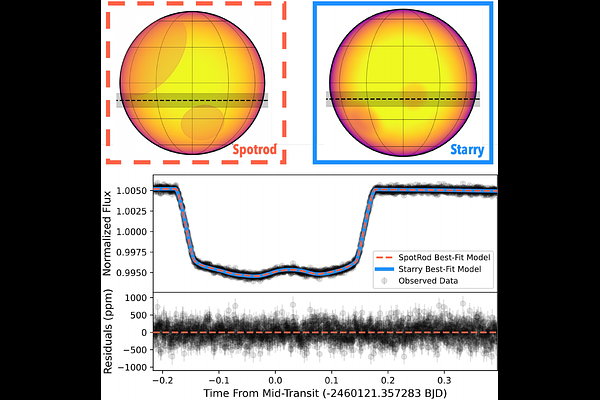The James Webb Space Telescope NIRSpec-PRISM Transmission Spectrum of the Super-Puff, Kepler-51d

The James Webb Space Telescope NIRSpec-PRISM Transmission Spectrum of the Super-Puff, Kepler-51d
Jessica E. Libby-Roberts, Aaron Bello-Arufe, Zachory K. Berta-Thompson, Caleb I. Cañas, Yayaati Chachan, Renyu Hu, Yui Kawashima, Catriona Murray, Kazumasa Ohno, Armen Tokadjian, Suvrath Mahadevan, Kento Masuda, Leslie Hebb, Caroline Morley, Guangwei Fu, Peter Gao, Kevin B. Stevenson
AbstractKepler-51 is a 500 Myr G dwarf hosting three "super-puffs" and one low-mass non-transiting planet. Kepler-51d, the coolest (T_eq ~ 350 K) transiting planet in this system, is also one of the lowest density super-puffs known to date (rho_p = 0.038 +/- 0.009 g/cm^3). With a planetary mass of Mp = 5.6 +/- 1.2 Earth masses and a radius of Rp = 9.32 +/- 0.18 Earth radii, the observed properties of this planet are not readily explained by most planet formation theories. Hypotheses explaining Kepler-51d's low density range from a substantial H/He envelope comprising more than 30% of its mass, to a high-altitude haze layer, to a tilted ring system. To test these hypotheses, we present the NIRSpec-PRISM 0.6-5.3 micron transmission spectrum of Kepler-51d observed by the James Webb Space Telescope. We find a spectrum best fit by a sloped line covering the entire wavelength range. Based on forward modeling and atmosphere retrievals, Kepler-51d likely possesses a low-metallicity atmosphere with high-altitude hazes of submicron particle sizes spanning pressures of 1-100 microbars. However, the spectrum could also be explained by a tilted ring with an estimated lifetime on the order of ~0.1 Myr. We also investigate the stellar activity of this young Sun-like star, extracting a spot temperature significantly hotter than sunspots and spot covering fractions on the order of 0.1-10%, depending on the assumed spot parameters.